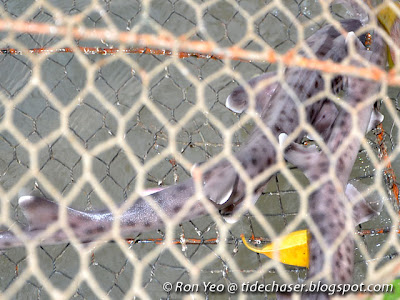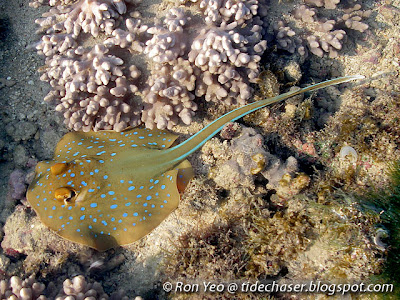Cartilaginous fishes (phylum Chordata, subphylum Vertebrata, class Chondrichthyes) are vertebrates (animals with a backbone and a hollow tube of nervous tissue called a spinal cord) characterised by having a skeleton made up of cartilage instead of bones. They also have tiny tooth-like scales (unlike the plate-like ones found on bony fishes) which make their outer coverings feel like sandpaper when touched.
Most of them have limited physiological means to maintain the body temperature within a narrow range (i.e. they are ectothermic animals), but some species are adapted to generate heat and maintain a higher body temperature compared to the surrounding water.
The mouths of cartilaginous fishes are usually located on the underside of their heads, unlike those of bony fishes which are usually located at the front tip.
They generally have keen senses of sight and smell, and possess electroreceptor organs which allow them to detect the electromagnetic fields produced by all living organisms.
Depending on the species, these fishes may lay eggs (oviparous), bear live young (viviparous), or bear live young from eggs brood within the body (ovoviviparous).
In Singapore, they are represented by the sharks and rays, and here are a few local examples.
A) ORDER CARCHARHINIFORMES
Sharks from this order mostly have two dorsal fins with no spines, one anal fin, and five gill slits. The eyes come with a nictitating fold or membrane (somewhat like a translucent eyelid).

The Blacktip Reef Shark (Carcharhinus melanopterus) is a small shark (maximum length about 2m) with a short, bluntly rounded snout, oval eyes, and sharp teeth. It is yellowish brown above and white below, with a prominent black blotch on its first dorsal fin. It is usually seen in coastal waters, feeding mostly on fishes and sometimes, crustaceans and molluscs. This species is viviparous (i.e. it bears live young). The above photo was unfortunately of a dead one found on Pulau Semakau.
B) ORDER ORECTOLOBIFORMES
Sharks of this family have two dorsal fins with no spines. The mouth is very short and usually well in front of the eyes. They have specialised nostrils that come with barbels.

The Slender Bamboo Shark (Chiloscyllium indicum) has a relatively shot snout. The body is brownish to greyish above with numerous dark spots or bars. It has a prominent longitudinal ridge on the middle of its back, and another pair of low ridges by the sides. This small shark gets to about 65cm long,and is usually found on sandy and muddy bottoms in coastal waters. It is oviparous (i.e. it lays eggs). The above sharks were caught in a fish trap set up by a fisherman.
C) ORDER TORPEDINIFORMES
This order comprises the electric rays, which are flattened cartilaginous fishes that are able to produce an electric discharge to stun their prey or to deter predators. All species are ovoviviparous, i.e. bearing live young from eggs brood within the body of the mother.

The Chinese Numbfish (Narcine lingula) has a brown coloration with dark brown blotches. It has two dorsal fins and an unforked tail fin. The head is equipped with electric organs, allowing it to produce electric discharges to stun small animals to feed on. This species can grow to about 33cm long.
C) ORDER MYLIOBATIFORMES
Rays of this order have greatly enlarged pectoral fins by the sides of the head, and a long tail. The dorsal fin is usually very much reduced or absent, and the tail fin is usually absent. The snout often functions as an electroreceptive organ, which can detect the electromagnetic fields produced by the prey, which may be buried under the soft substrate. The rays that I managed to photograph in Singapore are from the family Dasyatidae, commonly known as the whiptail stingrays or whiprays. They generally have long, whip-like tails with at least one long venomous spine. However, they only lash their tail if they feel threatened, so as to defend themselves against possible predators. A human stung by the spine will feel an excruciating pain, but it is rarely fatal. The sides of the head form a continuous margin connected to the pectoral fins. They breathe by drawing water through a small hole behind the eye, and then eject the water through the gill slits that are located on the underside of the disc. They are live-bearing (ovoviviparous), giving birth to fully developed young. Many species are consumed by human.

The Honeycomb Stingray (Himantura uarnak) is a large stingray that can reach lengths of more than 2m. It can be recognised by the conspicuous dark spots on a light brown disc. These spots are usually well-spaced in juveniles, but may form reticulated patterns as they mature. It has one sting on its very long tail, which can be more than three times the width of the disc. It can be found on sandy substrates, feeding on small animals such as fishes or invertebrates.

The Mangrove Whipray (Himantura walga) can be recognised by its pointed snout and a plain brownish coloration. It is usually found in mangrove forests and other muddy areas. This species can grow to about 60cm long, with the disc reaching about 25cm wide. It has several venomous spines on its tail.

The Blue-spotted Fantail Ray (Taeniura lymma) has an oval-shaped disc with a rounded snout, and broad skin folds under the back end of the disc. It has a brownish coloration, with the disc marked with bright blue spots. It can reach lengths of over 70cm, with one to two venomous spines on its tail.
References
Most of them have limited physiological means to maintain the body temperature within a narrow range (i.e. they are ectothermic animals), but some species are adapted to generate heat and maintain a higher body temperature compared to the surrounding water.
The mouths of cartilaginous fishes are usually located on the underside of their heads, unlike those of bony fishes which are usually located at the front tip.
They generally have keen senses of sight and smell, and possess electroreceptor organs which allow them to detect the electromagnetic fields produced by all living organisms.
Depending on the species, these fishes may lay eggs (oviparous), bear live young (viviparous), or bear live young from eggs brood within the body (ovoviviparous).
In Singapore, they are represented by the sharks and rays, and here are a few local examples.
A) ORDER CARCHARHINIFORMES
Sharks from this order mostly have two dorsal fins with no spines, one anal fin, and five gill slits. The eyes come with a nictitating fold or membrane (somewhat like a translucent eyelid).

The Blacktip Reef Shark (Carcharhinus melanopterus) is a small shark (maximum length about 2m) with a short, bluntly rounded snout, oval eyes, and sharp teeth. It is yellowish brown above and white below, with a prominent black blotch on its first dorsal fin. It is usually seen in coastal waters, feeding mostly on fishes and sometimes, crustaceans and molluscs. This species is viviparous (i.e. it bears live young). The above photo was unfortunately of a dead one found on Pulau Semakau.
B) ORDER ORECTOLOBIFORMES
Sharks of this family have two dorsal fins with no spines. The mouth is very short and usually well in front of the eyes. They have specialised nostrils that come with barbels.

The Slender Bamboo Shark (Chiloscyllium indicum) has a relatively shot snout. The body is brownish to greyish above with numerous dark spots or bars. It has a prominent longitudinal ridge on the middle of its back, and another pair of low ridges by the sides. This small shark gets to about 65cm long,and is usually found on sandy and muddy bottoms in coastal waters. It is oviparous (i.e. it lays eggs). The above sharks were caught in a fish trap set up by a fisherman.
C) ORDER TORPEDINIFORMES
This order comprises the electric rays, which are flattened cartilaginous fishes that are able to produce an electric discharge to stun their prey or to deter predators. All species are ovoviviparous, i.e. bearing live young from eggs brood within the body of the mother.

The Chinese Numbfish (Narcine lingula) has a brown coloration with dark brown blotches. It has two dorsal fins and an unforked tail fin. The head is equipped with electric organs, allowing it to produce electric discharges to stun small animals to feed on. This species can grow to about 33cm long.
C) ORDER MYLIOBATIFORMES
Rays of this order have greatly enlarged pectoral fins by the sides of the head, and a long tail. The dorsal fin is usually very much reduced or absent, and the tail fin is usually absent. The snout often functions as an electroreceptive organ, which can detect the electromagnetic fields produced by the prey, which may be buried under the soft substrate. The rays that I managed to photograph in Singapore are from the family Dasyatidae, commonly known as the whiptail stingrays or whiprays. They generally have long, whip-like tails with at least one long venomous spine. However, they only lash their tail if they feel threatened, so as to defend themselves against possible predators. A human stung by the spine will feel an excruciating pain, but it is rarely fatal. The sides of the head form a continuous margin connected to the pectoral fins. They breathe by drawing water through a small hole behind the eye, and then eject the water through the gill slits that are located on the underside of the disc. They are live-bearing (ovoviviparous), giving birth to fully developed young. Many species are consumed by human.

The Honeycomb Stingray (Himantura uarnak) is a large stingray that can reach lengths of more than 2m. It can be recognised by the conspicuous dark spots on a light brown disc. These spots are usually well-spaced in juveniles, but may form reticulated patterns as they mature. It has one sting on its very long tail, which can be more than three times the width of the disc. It can be found on sandy substrates, feeding on small animals such as fishes or invertebrates.

The Mangrove Whipray (Himantura walga) can be recognised by its pointed snout and a plain brownish coloration. It is usually found in mangrove forests and other muddy areas. This species can grow to about 60cm long, with the disc reaching about 25cm wide. It has several venomous spines on its tail.

The Blue-spotted Fantail Ray (Taeniura lymma) has an oval-shaped disc with a rounded snout, and broad skin folds under the back end of the disc. It has a brownish coloration, with the disc marked with bright blue spots. It can reach lengths of over 70cm, with one to two venomous spines on its tail.
References
- Allen, G. R. 1997. Marine fishes of South-east Asia. Periplus Editions, Hong Kong. 292 pp.
- Fisheries and Aquaculture Department, Food and Agriculture Organization of the United Nations. Fisheries and aquaculture fact sheets. Retrieved Apr 16, 2013, from http://www.fao.org/fishery/factsheets/en.
- Froese, R. & D. Pauly. Editors. 2013. FishBase, version (02/2013). Retrieved Apr 16, 2013, from http://www.fishbase.org.
- Lim, K.K.P & J. K. Y. Low. 1998. A guide to common marine fishes of Singapore. Singapore Science Centre, Singapore. 163 pp.

No comments:
Post a Comment